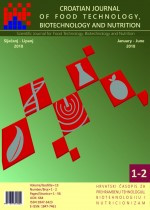The demand for plantain flour has increased in recent years due to its health benefits and industrial applications and information on the effect of drying methods on the physicochemical and functional characteristics of plantain flour in literature is limited. This present study was conducted to determine the effect of drying methods on the chemical, colour, functional and pasting properties of plantain flour were investigated. The results revealed that drying methods significantly (p<0.05) affected all the parameters studied. The moisture content of the flours ranged between 8.18 – 11.50%, fibre 2.56 – 3.21%, ash 3.00 – 3.30% and carbohydrate 76.18 – 80.49%. The L* of the samples ranged between 95.90 – 96.98, while the peak viscosity ranged between 432.04 - 461.37 RVU, final viscosity 320.40 – 484.58 RVU and pasting temperature 81.25 – 83.20°C across the drying methods used. Bulk density values varied between 0.68 – 0.70g/ml, WAC between 115.5 – 149.8%, OAC between 110.55 – 115.55% and swelling power 31.85 – 3.54%. Determination of suitable drying method is necessary for production of good quality plantain flour and the result suggest that any drying method could be used to produce good quality plantain flour.
Effect of drying methods on the chemical composition, colour, functional and pasting properties of plantain (Musa parasidiaca) flour /Gbemisola Jamiu Fadimu, Lateef Oladimeji Sanni, Abdul Rasaq Adebowale, Sarafadeen Kareem, Olajide Paul Sobukola, Olatundun Kajihausa, Abdulsam Saghir, Bernard Siwoku, Aminat Akinsanya, Monilola Kudirat Adenekan.
Sažetak
Dio od

 Hrvatski časopis za prehrambenu tehnologiju, biotehnologiju i nutricionizam : Croatian journal of food technology, biotechnology and nutrition : znanstveno- stručni časopis za prehrambenu tehnologiju, biotehnologiju i nutricionizam : 13,1-2(2018) / glavni urednik, editor-in-chief Jadranka Frece.
Hrvatski časopis za prehrambenu tehnologiju, biotehnologiju i nutricionizam : Croatian journal of food technology, biotechnology and nutrition : znanstveno- stručni časopis za prehrambenu tehnologiju, biotehnologiju i nutricionizam : 13,1-2(2018) / glavni urednik, editor-in-chief Jadranka Frece.